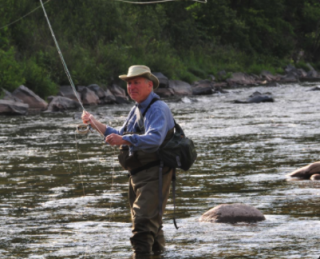Trout Season Opening Day

Harbingers of Spring are many and long in Lexington - our small but perfectly formed town hewn from the Catskill mountaintop along the banks of the Schoharie Creek and the West Kill.
None is more forceful, nor brings more joy, than the torrential rush of meltwater that comes at winter’s end and stains these vital arteries of the New York Watershed the color of strong tea.
This rich infusion, locked for months beneath feet of ice and snow on the high peaks that encircle Lexington, brings much needed nourishment to all manner of fauna being born or reawakening to the Spring.
Particularly grateful for this long-awaited meal are scores of trout – Brookies, Browns and Rainbows – that team these frigid waters as they have for millennia.
But for each fish fattening beneath the banks, there is an angler clad in waders and armed to the teeth with elaborate flies and lures, seeking to outsmart as many of these ancient salmonids as they can.
For both the battle begins on Opening Day.
“Opening Day of Trout season - April 1st – really is the first day of Spring,” says Judd Weisberg, long-time Lexington resident and nationally renowned flyfishing guide. “The anticipation for opening day is similar to a child waiting for Christmas morning, except we are waiting from when the season closes in mid-October. The anticipation is immense.”
From his workshop on the corner of Rt 42 and Rappleyea Road - he is also a sculptor and carpenter - Judd examines and sorts his fly boxes. The Schoharie’s springtime roar can be heard right outside the window and the banks swell perilously close to his front door.
“The flies we fish with are imitations of the many lifeforms fish feed on – whether minnow or crustaceans or flies and larvae. We try to imitate them all.”
From his workshop vantage-point Judd keeps a close eye on another important signal that Spring is upon us.
“Keeping close watch on the condition of the water is very important,” he says. “Opening day is April 1st, but what we want is for the water to clear so we can see the fish rising to the surface to feed.”
The Schoharie is a haven for trout and bass and both species are sight feeders – that is they eat what they can see. “This is one of the many beauties of fly fishing,” says Judd. “The pursuit begins with tying the fly. It has to be attractive enough to really get the fish going when they see it. You can spend as much time, if not more, perfecting your flies and lures to actually fishing.”
There are few people with as much knowledge of the Schoharie and its secrets as Judd.
“The Schoharie is my natal stream,” he says. “This is where I first fell in love with the natural world. All life springs from the Schoharie for me. The purity of it is sublime, which is why this is where New York City gets its drinking water. There is such a wealth of natural beauty in this river. It is magic really.”
The Schoharie in Lexington and West Kill holds almost mythic status among fly-fishers in the United States. Arthur B. Flick, known as Art, wrote his seminal “Streamside Guide” here and his parents owned the West Kill Tavern. His disciples still come in regular droves to fish his favorite haunts with his legendary flies.
It is not coincidental that these waters are particularly special to trout fishers. Indeed, many are convinced that the waters of the West Kill, an important tributary of the Schoharie, is home to a unique species of trout known locally as the West Kill Brookie.
“The brook trout found here in the West Kill is the only Eastern native salmonid in the United States,” says Mike Barcone, proprietor of West Kill Brewing, maker of a fine American lager named in honor of the fish. “Brown Trout are stocked by the DEC and originate in Germany. The Rainbows, also stocked, are from the Western United States.”
Brook trout are very picky about the quality of water they swim in, which must be highly oxygenated and with plenty of food. The West Kill, and the Schoharie into which it flows, have both attributes in abundance.
“This has been a major brook trout fishery right back to the Ice age,” says Barcone, who is working with the New York Department of Environmental Conservation (DEC) and a group called Trout Unlimited to verify the unique DNA of the West Kill Brookie.
“We are hopefully very close to getting the evidence to prove we have a unique subspecies of fish here, meaning there will be even more reason to visit these unique waters.”
The DEC has also recently begun work on a habitat restoration program to help the riverbank cope with the rigors of storm damage and erosion that seem to be intensifying in the age of climate change.
Opening day is just the beginning. We have more than six months of near perfect trout fishing ahead of us here in Lexington and West Kill that will be enjoyed by thousands of visitors.
There are a great many official fishing spots in town designated by the state, and many more besides that can be accessed with permission from landowners. Licenses to fish can be obtained from the Lexington town clerk.
The chill of October is a long way off and what better way to enjoy the summer months than on the banks of the Schoharie Creek or the West Kill with a fly rod in hand and a six pack of Barcone’s West Kill Brookies in your cooler.
Come and see for yourself.

